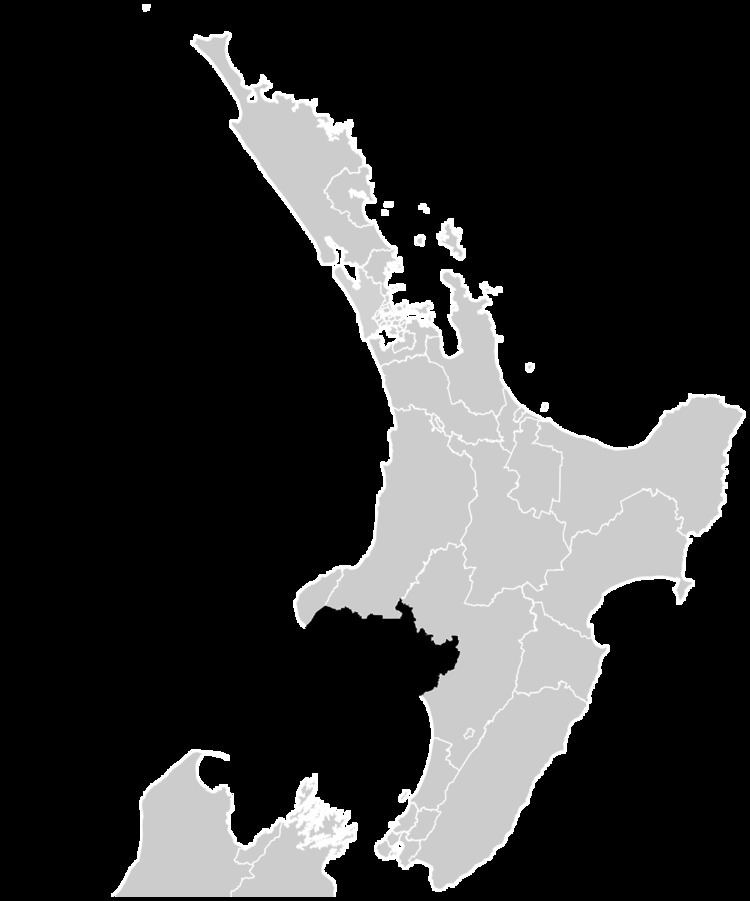 | ||
Whanganui (known as Wanganui until 1996) is a New Zealand parliamentary electorate. It was first established in 1860 for the 3rd Parliament and has existed continuously since then.
Contents
Since the 2005 election, it has been held by Chester Borrows of the National Party.
Population centres
In the 1860 electoral redistribution, the House of Representatives increased the number of representatives by 12, reflecting the immense population growth since the original electorates were established in 1853. The redistribution created 15 additional electorates with between one and three members, and the Wanganui and Rangitikei electorate was split into two separate electorates: the Rangitikei electorate and the Wanganui electorate.
The electorate is based on the city of Whanganui, the towns Opunake and Hawera, and smaller centres Kaponga, Eltham, Normanby, Manaia, Patea and Waverley.
History
Henry Shafto Harrison was the first representative. His 7 February 1861 election was declared invalid. He stood again in the 1861 by-election and was elected again. He then served the electorate until the end of the term in 1866.
Harrison, John Bryce and John Garner contested the 1866 election. The nomination meeting was held on Friday, 2 March 1866. Harrison, Bryce and Garner received 51, 102 and 7 votes, respectively, at the election on the following day. Bryce was thus declared elected. Bryce resigned in 1867.
The resulting 6 May 1867 by-election was won by Harrison, and he served until the dissolution of Parliament on 30 December 1870.
Bryce was again elected in the 30 January 1871 election. This time, he served three parliamentary terms until the dissolution in November 1881.
Wanganui became a two-member electorate for the 12 January 1875–76 election. Apart from Bryce, Julius Vogel was elected, who was later to become Premier. Vogel resigned on 9 September 1876.
The resulting 2 October 1876 by-election was won by William Fox, resulting in his second period of representation of this electorate. He served until the end of the term on 15 August 1879.
Bryce and John Ballance won the 1879 election. They both server until the end of the term, with Parliament being dissolved on 8 November 1881.
For the 1881 election, the electorate reverted to being represented by a single member. The election, held on 9 December, was won by William Hogg Watt. He served until the end of the term, with Parliament being dissolved on 27 June 1884.
The 1884 election was once again won by John Ballance. This time, he would serve in three successive Parliaments. He died in office on 27 April 1893 during the 11th Parliament. Ballance formed the Liberal Party after the 1890 election and became its leader, and thus introduced party politics to New Zealand. The Liberal Government of New Zealand would last for 21 years and is the longest serving government in New Zealand's history.
Ballance’s death triggered the 1893 by-election, which was held on 13 June and won by Archibald Willis, who was re-elected at the 1893 election a few months later.
Gilbert Carson was successful in the 1896 election. He served one term. He was succeeded by Willis in the 1899 election, who served two more terms for the electorate.
James Thomas Hogan won the 1905 election. He served two terms and was defeated in the 1911 election by Bill Veitch.
Veitch had a long career in the electorate, serving until 1935, when he defeated. He was initially an Independent, but joined the Liberal Party in 1925, and changed to the United Party in 1928.
Joseph Cotterill won the electorate in the 1935 election for the Labour Party. He also had a long career, retiring in 1960 from the Wanganui seat.
He was succeeded by his party colleague George Spooner in the 1960 election, who served three terms and was defeated in 1969 election by William Tolhurst from the National Party.
Tolhurst served one term and at the 1972 election, the electorate returned to Labour. Russell Marshall served six terms and retired in 1990.
In the 1990 election, Cam Campion secured the seat for National. He retired in 1993 and died two years after that.
The seat returned to Labour again, with Jill Pettis winning the 1993 election. She was the first woman to represent Wanganui. She served four terms, until she was defeated in the 2005 election by current holder of the electorate, Chester Borrows of the National Party. Pettis served an additional term as a List MP until 2008.
Several members (Fox, Vogel and Ballance) became Premier. Terry Heffernan stood in the electorate five times for four parties, from 1981 to 1993.
Members of Parliament
Unless otherwise stated, all MPs terms began and ended at a general election.
Key
Independent Liberal Conservative Liberal-Labour United Labour United Labour National
List MPs
Members of Parliament elected from party lists in elections where that person also unsuccessfully contested the electorate. Unless otherwise stated, all MPs terms began and ended at general elections.
2011 election
Electorate (as at 11 November 2011): 43,350
